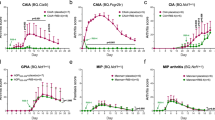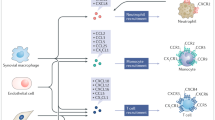Abstract
The chemokine receptor CCR7 and its ligands CCL19 and CCL21 guide the homing and positioning of dendritic and T cells in lymphoid organs, thereby contributing to several aspects of adaptive immunity and immune tolerance. In the present study, we investigated the role of CCR7 in the pathogenesis of collagen-induced arthritis (CIA). By using a novel anti-human CCR7 antibody and humanized CCR7 mice, we evaluated CCR7 as a target in this autoimmune model of rheumatoid arthritis (RA). Ccr7-deficient mice were completely resistant to CIA and presented severely impaired antibody responses to collagen II (CII). Selective CCR7 expression on dendritic cells restored arthritis severity and anti-CII antibody titers. Prophylactic and therapeutic treatment of humanized CCR7 mice with anti-human CCR7 mAb 8H3-16A12 led to complete resistance to CIA and halted CIA progression, respectively. Our data demonstrate that CCR7 signaling is essential for the induction of CIA and identify CCR7 as a potential therapeutic target in RA.
This is a preview of subscription content, access via your institution
Access options
Subscribe to this journal
Receive 12 digital issues and online access to articles
$119.00 per year
only $9.92 per issue
Buy this article
- Purchase on Springer Link
- Instant access to full article PDF
Prices may be subject to local taxes which are calculated during checkout





Similar content being viewed by others
References
Smolen, J. S., Aletaha, D. & McInnes, I. B. Rheumatoid arthritis. Lancet 388, 2023–2038 (2016).
Schulz, O., Hammerschmidt, S. I., Moschovakis, G. L. & Forster, R. Chemokines and chemokine receptors in lymphoid tissue dynamics. Annu Rev. Immunol. 34, 203–242 (2016).
Comerford, I. et al. A myriad of functions and complex regulation of the CCR7/CCL19/CCL21 chemokine axis in the adaptive immune system. Cytokine Growth Factor Rev. 24, 269–283 (2013).
Forster, R., Davalos-Misslitz, A. C. & Rot, A. CCR7 and its ligands: balancing immunity and tolerance. Nat. Rev. Immunol. 8, 362–371 (2008).
Hjelmstrom, P., Fjell, J., Nakagawa, T., Sacca, R., & Cuff, C. A., & Ruddle, N.H. Lymphoid tissue homing chemokines are expressed in chronic inflammation. Am. J. Pathol. 156, 1133–1138 (2000).
Weninger, W. et al. Naive T cell recruitment to nonlymphoid tissues: a role for endothelium-expressed CC chemokine ligand 21 in autoimmune disease and lymphoid neogenesis. J. Immunol. 170, 4638–4648 (2003).
Burman, A. et al. A chemokine-dependent stromal induction mechanism for aberrant lymphocyte accumulation and compromised lymphatic return in rheumatoid arthritis. J. Immunol. 174, 1693–1700 (2005).
Page, G., Lebecque, S. & Miossec, P. Anatomic localization of immature and mature dendritic cells in an ectopic lymphoid organ: correlation with selective chemokine expression in rheumatoid synovium. J. Immunol. 168, 5333–5341 (2002).
Bruhl, H. et al. Functional expression of the chemokine receptor CCR7 on fibroblast-like synoviocytes. Rheumatol. (Oxf.) 47, 1771–1774 (2008).
Pickens, S. R. et al. Characterization of CCL19 and CCL21 in rheumatoid arthritis. Arthritis Rheum. 63, 914–922 (2011).
Pickens, S. R. et al. Role of the CCL21 and CCR7 pathways in rheumatoid arthritis angiogenesis. Arthritis Rheum. 64, 2471–2481 (2012).
Wengner, A. M. et al. CXCR5- and CCR7-dependent lymphoid neogenesis in a murine model of chronic antigen-induced arthritis. Arthritis Rheum. 56, 3271–3283 (2007).
Schneider, M. A., Meingassner, J. G., Lipp, M., Moore, H. D. & Rot, A. CCR7 is required for the in vivo function of CD4 + CD25 + regulatory T cells. J. Exp. Med 204, 735–745 (2007).
Mori, S. et al. Mice lacking expression of the chemokines CCL21-ser and CCL19 (plt mice) demonstrate delayed but enhanced T cell immune responses. J. Exp. Med 193, 207–218 (2001).
Stuart, J. M. & Dixon, F. J. Serum transfer of collagen-induced arthritis in mice. J. Exp. Med 158, 378–392 (1983).
Ivanov, S. et al. CCR7 and IRF4-dependent dendritic cells regulate lymphatic collecting vessel permeability. J. Clin. Invest 126, 1581–1591 (2016).
Wendland, M. et al. Lymph node T cell homeostasis relies on steady state homing of dendritic cells. Immunity 35, 945–957 (2011).
Chatenoud, L., Ferran, C. & Bach, J. F. The anti-CD3-induced syndrome: a consequence of massive in vivo cell activation. Curr. Top. Microbiol Immunol. 174, 121–134 (1991).
Ferran, C. et al. Cytokine-related syndrome following injection of anti-CD3 monoclonal antibody: further evidence for transient in vivo T cell activation. Eur. J. Immunol. 20, 509–515 (1990).
Maude, S. L., Barrett, D., Teachey, D. T. & Grupp, S. A. Managing cytokine release syndrome associated with novel T cell-engaging therapies. Cancer J. 20, 119–122 (2014).
Kocks, J. R., Davalos-Misslitz, A. C., Hintzen, G., Ohl, L. & Forster, R. Regulatory T cells interfere with the development of bronchus-associated lymphoid tissue. J. Exp. Med 204, 723–734 (2007).
Mzinza, D. T., et al. Application of light sheet microscopy for qualitative and quantitative analysis of bronchus-associated lymphoid tissue in mice. Cell. Mol. Immunol. (2018). https://doi.org/10.1038/cmi.2017.150
Davalos-Misslitz, A. C. et al. Generalized multi-organ autoimmunity in CCR7-deficient mice. Eur. J. Immunol. 37, 613–622 (2007).
Winter, S. et al. Manifestation of spontaneous and early autoimmune gastritis in CCR7-deficient mice. Am. J. Pathol. 179, 754–765 (2011).
Ganguly, D., Haak, S., Sisirak, V. & Reizis, B. The role of dendritic cells in autoimmunity. Nat. Rev. Immunol. 13, 566–577 (2013).
Forster, R. et al. CCR7 coordinates the primary immune response by establishing functional microenvironments in secondary lymphoid organs. Cell 99, 23–33 (1999).
Moschovakis, G. L. et al. Deficient CCR7 signaling promotes TH2 polarization and B-cell activation in vivo. Eur. J. Immunol. 42, 48–57 (2012).
Morgan, M. E. et al. CD25 + cell depletion hastens the onset of severe disease in collagen-induced arthritis. Arthritis Rheum. 48, 1452–1460 (2003).
Kohm, A. P., Carpentier, P. A., Anger, H. A. & Miller, S. D. Cutting edge: CD4 + CD25 + regulatory T cells suppress antigen-specific autoreactive immune responses and central nervous system inflammation during active experimental autoimmune encephalomyelitis. J. Immunol. 169, 4712–4716 (2002).
Morgan, M. E. et al. Effective treatment of collagen-induced arthritis by adoptive transfer of CD25 + regulatory T cells. Arthritis Rheum. 52, 2212–2221 (2005).
Mottet, C., Uhlig, H. H. & Powrie, F. Cutting edge: cure of colitis by CD4 + CD25 + regulatory T cells. J. Immunol. 170, 3939–3943 (2003).
Isaacs, J. D. Therapeutic T-cell manipulation in rheumatoid arthritis: past, present and future. Rheumatol. (Oxf.) 47, 1461–1468 (2008).
Epstein, W. V. Expectation bias in rheumatoid arthritis clinical trials. The anti-CD4 monoclonal antibody experience. Arthritis Rheum. 39, 1773–1780 (1996).
Strand, V., Kimberly, R. & Isaacs, J. D. Biologic therapies in rheumatology: lessons learned, future directions. Nat. Rev. Drug Discov. 6, 75–92 (2007).
Depis, F. et al. Long-term amelioration of established collagen-induced arthritis achieved with short-term therapy combining anti-CD3 and anti-tumor necrosis factor treatments. Arthritis Rheum. 64, 3189–3198 (2012).
Penaranda, C., Tang, Q. & Bluestone, J. A. Anti-CD3 therapy promotes tolerance by selectively depleting pathogenic cells while preserving regulatory T cells. J. Immunol. 187, 2015–2022 (2011).
Ohl, L. et al. CCR7 governs skin dendritic cell migration under inflammatory and steady-state conditions. Immunity 21, 279–288 (2004).
Zietara, N. et al. Multicongenic fate mapping quantification of dynamics of thymus colonization. J. Exp. Med 212, 1589–1601 (2015).
Inglis, J. J. et al. Collagen-induced arthritis in C57BL/6 mice is associated with a robust and sustained T-cell response to type II collagen. Arthritis Res Ther. 9, R113 (2007).
Moschovakis, G. L. et al. T cell specific Cxcr5 deficiency prevents rheumatoid arthritis. Sci. Rep. 7, 8933 (2017).
Pfeifle, R. et al. Regulation of autoantibody activity by the IL-23-TH17 axis determines the onset of autoimmune disease. Nat. Immunol. 18, 104–113 (2017).
Acknowledgements
We thank Linda Oberdörfer, Kerstin Daemen, and Jana Keil for excellent technical assistance and Svetlana Piter for excellent animal care. This work was supported by Deutsche Forschungsgemeinschaft (DFG) grant KFO 250-FO 334/2-1 to R. Förster.
Author information
Authors and Affiliations
Contributions
G.L.M., A.B., M.F., and J.R. performed experiments; G.L.M. and C.S.F. analyzed experiments; J.W.B. and E.K. provided essential reagents for the study; G.L.M. and R.F. designed experiments and wrote the paper. The manuscript was approved by all authors.
Corresponding authors
Ethics declarations
Competing interests
G.L.M., A.B., M.F., J.R., C.S.F., E.K., and R.F. declare no conflicts of interest. J.W.B. is an employee of Pepscan and was named inventor on a patent disclosing anti-CCR7 antibodies.
Additional information
Publisher's note: Springer Nature remains neutral with regard to jurisdictional claims in published maps and institutional affiliations.
Rights and permissions
About this article
Cite this article
Moschovakis, G.L., Bubke, A., Friedrichsen, M. et al. The chemokine receptor CCR7 is a promising target for rheumatoid arthritis therapy. Cell Mol Immunol 16, 791–799 (2019). https://doi.org/10.1038/s41423-018-0056-5
Received:
Accepted:
Published:
Issue Date:
DOI: https://doi.org/10.1038/s41423-018-0056-5
This article is cited by
-
Signaling pathways involved in the biological functions of dendritic cells and their implications for disease treatment
Molecular Biomedicine (2023)
-
WGCNA and molecular docking reveal key hub genes and potential natural inhibitor in interstitial cystitis/bladder pain syndrome
International Urogynecology Journal (2022)
-
Dendritic cell migration in inflammation and immunity
Cellular & Molecular Immunology (2021)
-
Accumulation of synovial fluid CD19+CD24hiCD27+ B cells was associated with bone destruction in rheumatoid arthritis
Scientific Reports (2020)
-
CCL21/CCR7 signaling in macrophages promotes joint inflammation and Th17-mediated osteoclast formation in rheumatoid arthritis
Cellular and Molecular Life Sciences (2020)



